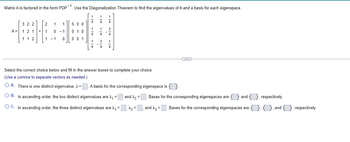
Advanced Engineering Mathematics
10th Edition
ISBN: 9780470458365
Author: Erwin Kreyszig
Publisher: Wiley, John & Sons, Incorporated
expand_more
expand_more
format_list_bulleted
Question

Transcribed Image Text:Matrix A is factored in the form PDP-1. Use the Diagonalization Theorem to find the eigenvalues of A and a basis for each eigenspace.
A =
322
1 2 1 =
112
2
1
1
1
1
0 - 1
0
- 1
500
0 1 0
001
1
4
1
4
1
4
1
4
1
4
3
1
4
3
4
1
4
Select the correct choice below and fill in the answer boxes to complete your choice.
(Use comma to separate vectors as needed.)
O A. There is one distinct eigenvalue, λ = A basis for the corresponding eigenspace is
OB. In ascending order, the two distinct eigenvalues are ^, =
O C. In ascending order, the three distinct eigenvalues are ₁ =
and =
-C
Bases for the corresponding eigenspaces are and { }, respectively.
^₂=₁, and 23: Bases for the corresponding eigenspaces are 4., and respectively.
=
Expert Solution
This question has been solved!
Explore an expertly crafted, step-by-step solution for a thorough understanding of key concepts.
This is a popular solution
Trending nowThis is a popular solution!
Step by stepSolved in 3 steps

Knowledge Booster
Similar questions
- For the matrix A, find (if possible) a nonsingular matrix P such that PAP is diagonal. (If not possible, enter IMPOSSIBLE.) 2 -2 5 A = 3 -2 L0 -1 2 P = Verify that PAP is a diagonal matrix with the eigenvalues on the main diagonal. p-1AP =arrow_forwardDiagonlize the matrix if possible. the eigenvalues are as follows λ=3,1 7 4 16 2 5 8 -2 -2 -5arrow_forwardFind the eigenvalues of the symmetric matrix. (Enter your answers as a comma-separated list. Enter your answers from smallest to largest.) 0 9 9 9 0 9 9 9 9 d; = For each eigenvalue, find the dimension of the corresponding eigenspace. (Enter your answers as a comma-separated list.) dim(x;) =arrow_forward
- Find a basis for the eigenspace corresponding to the eigenvalue. 4 - 3 3 A = 6 , 1 = 3 - 2 -6 -3 A basis for the eigenspace corresponding to 1 = 3 is { }. (Type a vector or list of vectors. Type an integer or simplified fraction for each matrix element. Use a comma to separate answers as needed.)arrow_forwardMatrix A is factored in the form PDP¯1. Use the Diagonalization Theorem to find the eigenvalues of A and a basis for each eigenspace. 20 - 16 – 40 - 1 6 0 0 0 0 1 A= 8 6 32 1 060 2 1 8 0 0 6 1 0 0 0 0 2 -10 - 4 Select the correct choice below and fill in the answer boxes to complete your choice. (Use a comma to separate vectors as needed.) O A. There is one distinct eigenvalue, À = A basis for the corresponding eigenspace is { }. O B. In ascending order, the two distinct eigenvalues are = and 2 = Bases for the corresponding eigenspaces are { } and {}, respectively. O C. In ascending order, the three distinct eigenvalues are , = 12 = Bases for the corresponding eigenspaces are {}. { }, and {}, respectively. and A3 = Click to select and enter your answer(s). DELLarrow_forwardFind the matrix A of the quadratic form associated with the equation. 4x² - 6xy - 4y² + 6 = 0 A = 4 -3 P = -3 -4 Find the eigenvalues of A. (Enter your answers as a comma-separated list.) λ = 5, -5 Find an orthogonal matrix P such that PTAP is diagonal. (Enter the matrix in the form [[row 1], [row 2], ...], where each row is a comma-separated list.) [1,0], [0,1]arrow_forward
- For the matrix, list the real eigenvalues, repeated according to their multiplicities. The real eigenvalues are (Use a comma to separate answers as needed.) 8-40 8 6 5 -5 03 8 00 8 0 0 0arrow_forwardFind the eigenvalues of the symmetric matrix. (Enter your answers as a comma-separated list. Enter your answers from smallest to largest.) 033 0 3 3 3 3 λ; = For each eigenvalue, find the dimension of the corresponding eigenspace. (Enter your answers as a comma-separated list.) dim(x;) =arrow_forward
arrow_back_ios
arrow_forward_ios
Recommended textbooks for you
 Advanced Engineering MathematicsAdvanced MathISBN:9780470458365Author:Erwin KreyszigPublisher:Wiley, John & Sons, Incorporated
Advanced Engineering MathematicsAdvanced MathISBN:9780470458365Author:Erwin KreyszigPublisher:Wiley, John & Sons, Incorporated Numerical Methods for EngineersAdvanced MathISBN:9780073397924Author:Steven C. Chapra Dr., Raymond P. CanalePublisher:McGraw-Hill Education
Numerical Methods for EngineersAdvanced MathISBN:9780073397924Author:Steven C. Chapra Dr., Raymond P. CanalePublisher:McGraw-Hill Education Introductory Mathematics for Engineering Applicat...Advanced MathISBN:9781118141809Author:Nathan KlingbeilPublisher:WILEY
Introductory Mathematics for Engineering Applicat...Advanced MathISBN:9781118141809Author:Nathan KlingbeilPublisher:WILEY Mathematics For Machine TechnologyAdvanced MathISBN:9781337798310Author:Peterson, John.Publisher:Cengage Learning,
Mathematics For Machine TechnologyAdvanced MathISBN:9781337798310Author:Peterson, John.Publisher:Cengage Learning,


Advanced Engineering Mathematics
Advanced Math
ISBN:9780470458365
Author:Erwin Kreyszig
Publisher:Wiley, John & Sons, Incorporated

Numerical Methods for Engineers
Advanced Math
ISBN:9780073397924
Author:Steven C. Chapra Dr., Raymond P. Canale
Publisher:McGraw-Hill Education

Introductory Mathematics for Engineering Applicat...
Advanced Math
ISBN:9781118141809
Author:Nathan Klingbeil
Publisher:WILEY

Mathematics For Machine Technology
Advanced Math
ISBN:9781337798310
Author:Peterson, John.
Publisher:Cengage Learning,

